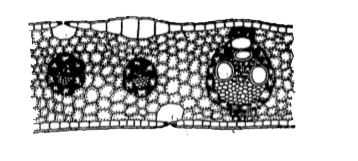LEAF VENATION
Step-by-Step Solution for the Question: What is Leaf Venation?
1. Definition of Leaf Venation: Leaf venation refers to the arrangement of veins in a leaf. It is an important aspect of the leaf structure that helps in understanding how plants transport nutrients and water.
2. Understanding Veins: In the context of leaves, veins are small, line-like structures that extend from a central part of the leaf. These veins are crucial for the leaf's function.
3. Role of the Midrib: The midrib is the central vein that runs down the middle of the leaf. It serves as the main support structure from which other smaller veins branch out.
4. Function of Leaf Veins: The primary function of the veins in a leaf is to transport water and minerals from the plant's roots to the leaf and to distribute the products of photosynthesis throughout the plant.
5. Types of Leaf Venation: Leaf venation can vary from one plant species to another. There are different patterns of vein arrangements, which can be classified into two main types:
- Parallel Venation: Where the veins run parallel to each other (common in monocots).
- Reticulate Venation: Where the veins form a network (common in dicots).
6. Conclusion: In summary, leaf venation is the specific arrangement of veins in a leaf, which plays a vital role in the leaf's ability to function effectively in the plant's overall health and growth.
- Parallel Venation: Where the veins run parallel to each other (common in monocots).
- Reticulate Venation: Where the veins form a network (common in dicots).
Similar Questions
Knowledge Check
Assertion: Calophyllum leaf has parallel venation.
Reason: It is the plant of dicot group of angiosperms.AIf both Assertion and Reason are true and the Reason is the correct explanation of the Assertion.BIf both Assertion and Reason are true, but the Reason is not the correct explanation of the Assertion.CIf Assertion is true, but Reason is false.DIf both Assertion and Reason are false.Leaf of which of the following plant shows circinate venation at yound stage
AFermBMangoCHydrillaDFunariaWhich of the following statements are not correct regarding this?

I. It is an isobilateral leaf.
II. The leaf shows reticulate venation.
III. The leaf may exhibit kranz anatomy.
IV. Such type of leaf may bë present in plants undergoing C4 pathway.
V. Mësophyll is differentiated into palisade and spongy parenchyma.
VI. Such type of leaf is found in hydrophytes.
VII. Such type of leaf is found in meņbers of Family Poaceae.AI, II and IVBI, III, IV and VIICII, V and VIDIII, V, VI and VII
Characterstics Of Leaf|Functions Of Leaf|Parts Of Leaf|Leaf Veination
View SolutionAnatomy OF Leaf || Dorsiventral Leaf || Isobilateral Leaf
View SolutionVenation, Shape of seeds, Leaf petiole Leaf shape
View SolutionLeaf basic features || functions || structural parts || types of leaves || venation || phyllotaxy types || modifications of leaves
View SolutionAssertion : A simple leaf has undivided lamina
Reason : Leaves showing pinnate and palmate venation have various type of incisions.
View Solution
